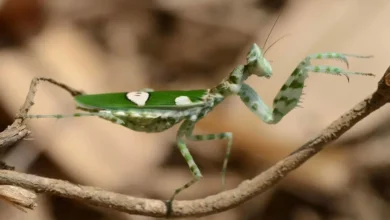Stagmatoptera biocellata is a captivating species of praying mantis renowned for its striking appearance and unique behaviors. This mantis, native to South America, is a popular choice among insect enthusiasts due to its vibrant colors, impressive size, and relatively easy care in captivity.
Characteristics:
Comparison of Stagmatoptera biocellata and Other Mantis Species
| Feature | Stagmatoptera biocellata | Mantis religiosa | Hymenopus coronatus |
|---|---|---|---|
| Common name | Brazilian Eyes Mantis | European Mantis | Orchid Mantis |
| Size | Large (up to 10 cm) | Medium | Small to medium |
| Coloration | Vibrant green with eye spots | Green or brown | Pink or white, resembling an orchid |
| Habitat | Tropical rainforests | Various habitats | Tropical forests |
| Distinctive features | Large eye spots, vibrant green | Versatile coloration, simple morphology | Resembles an orchid flower |
Images:
Care in Captivity:

- Enclosure: A tall terrarium with plenty of ventilation is ideal. Live plants can provide hiding spots and enhance the natural environment.
- Temperature: Maintain a temperature range of 24-28°C (75-82°F) during the day and slightly cooler at night.
- Humidity: High humidity is essential. Regular misting is recommended.
- Diet: Offer a varied diet of live insects, such as crickets, flies, and roaches.
- Handling: While these mantises are relatively docile, handling should be minimized to reduce stress.
Unique Behaviors:
- Mimicry: The large, eye-like spots on its forewings serve as a form of mimicry, deterring potential predators.
- Hunting: Stagmatoptera biocellata is an ambush predator, patiently waiting for prey to come within striking distance.
Why Stagmatoptera biocellata is Popular:
- Striking appearance: Its vibrant coloration and unique eye spots make it a visually appealing insect.
- Relatively easy care: With the right conditions, these mantises can thrive in captivity.
- Interesting behavior: Their hunting techniques and defensive displays are fascinating to observe.
Would you like to know more about this amazing species? I can provide information on topics such as breeding, molting, or specific care requirements.



